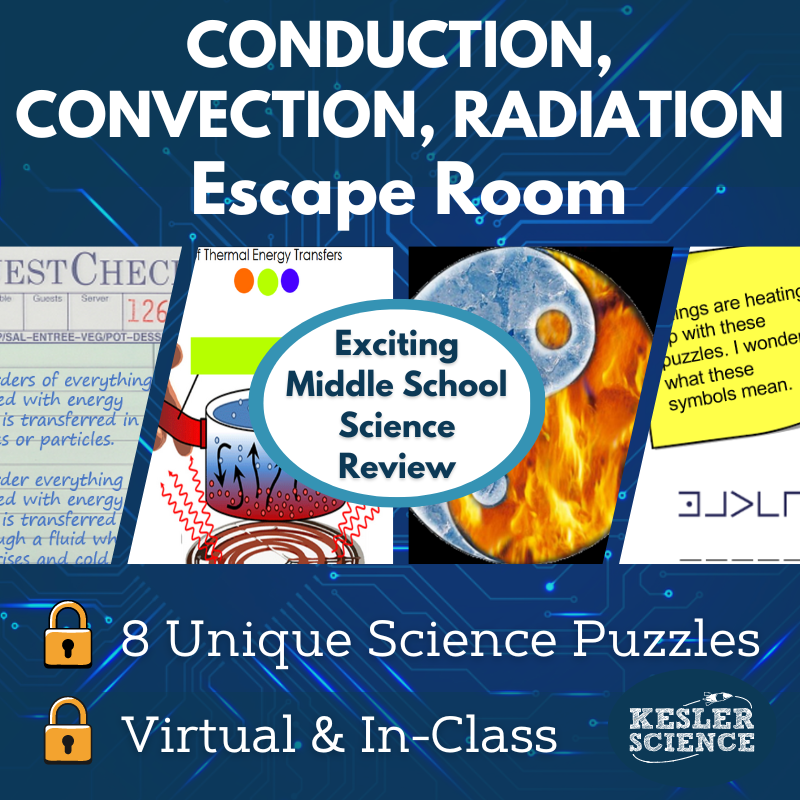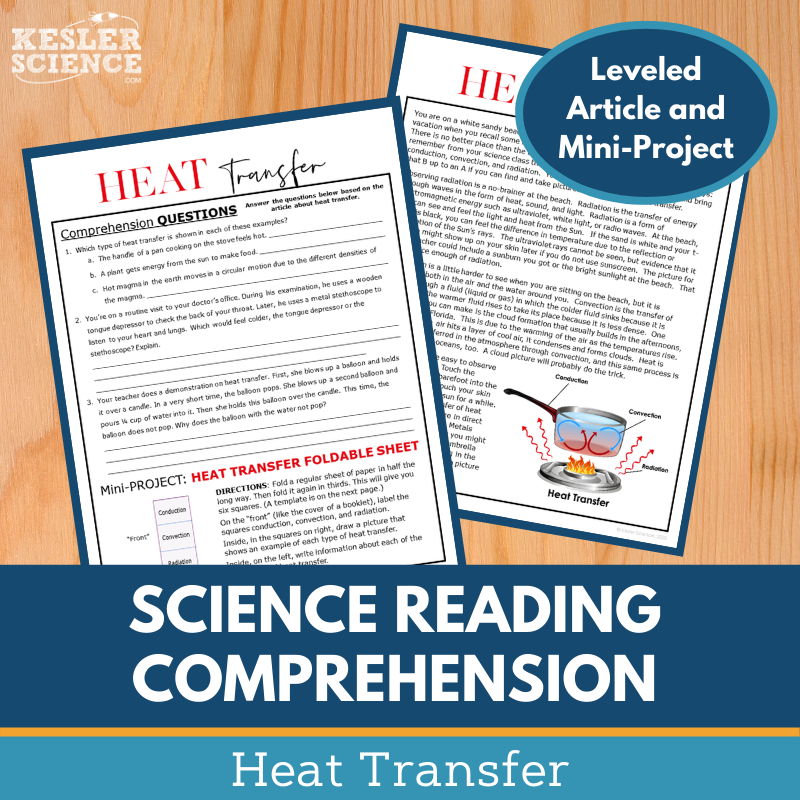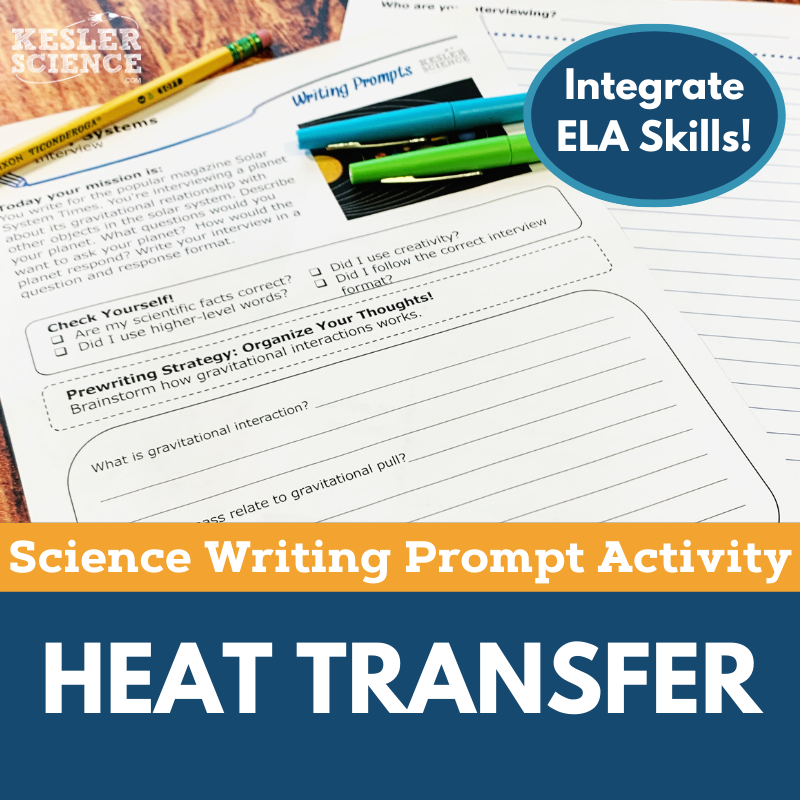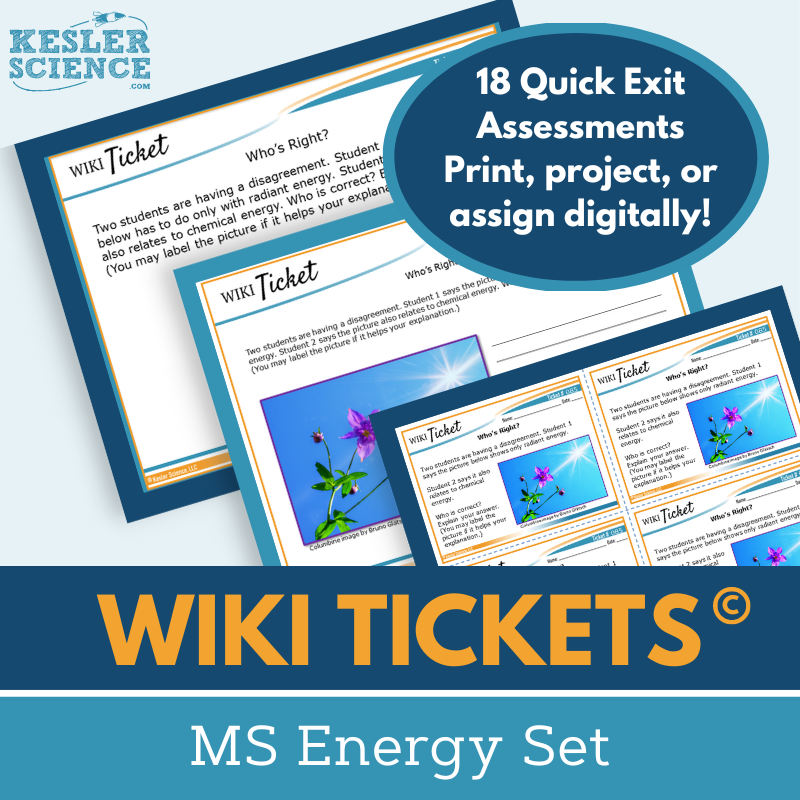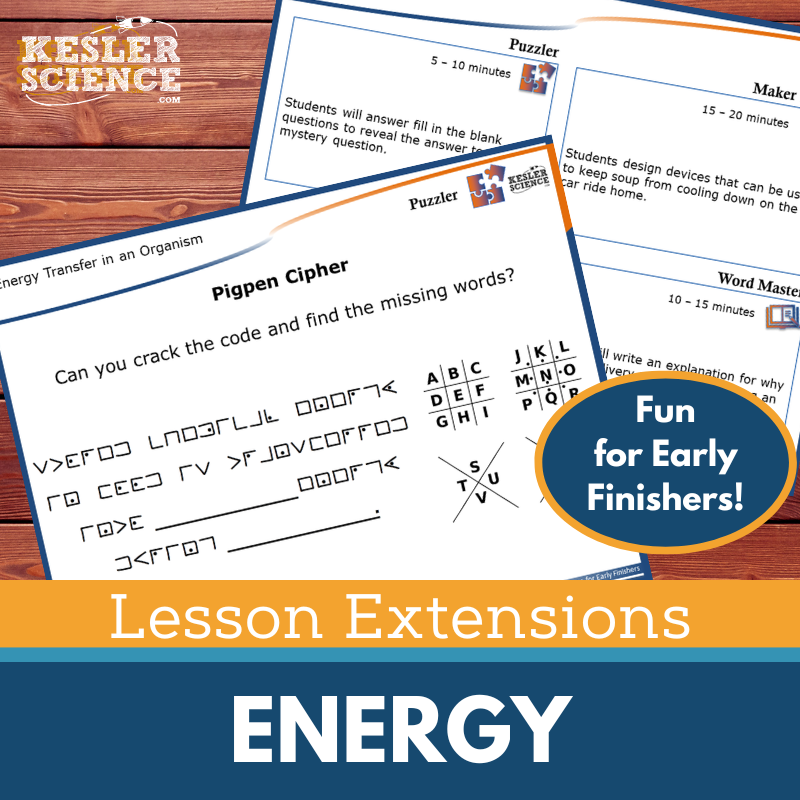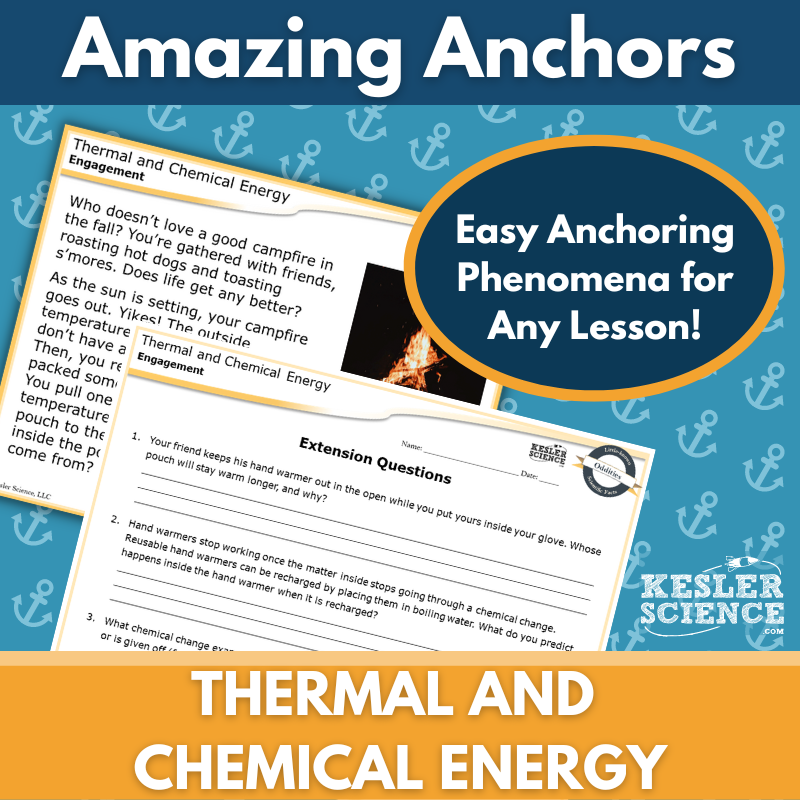Thermal Energy in Systems Activities for Middle School Science
This Thermal Energy in Systems unit covers methods of thermal energy transfer, including conduction, convection, and radiation. The resources below will give students a comprehensive understanding of thermal energy transfer. All of the following materials are also included in the Kesler Science Membership.
This Thermal Energy in Systems unit explores methods of thermal energy transfer, including conduction, convection, and radiation. It features presentations, worksheets, choice projects, and assessments, all fully editable and ready to use with minimal preparation. The lesson supports differentiated, student-led learning to maximize student success.
Students will engage with essential questions about how energy transfers and the methods of thermal energy transfer. The lesson follows the 5E Model: engagement, exploration, explanation, elaboration, and evaluation. During the exploration phase, students participate in a differentiated station lab, exploring concepts through hands-on demos, reading passages, research, videos, and activities to demonstrate their understanding. The lesson also includes editable PowerPoints, interactive notebooks in English and Spanish, and various activities to reinforce learning.
For elaboration, students can extend their learning through choice projects. Evaluation includes updated assessment questions for STAAR 2.0, along with review questions and worksheets. This unit is perfect for in-class or virtual learning environments.
This Thermal Energy in Systems unit explores methods of thermal energy transfer, including conduction, convection, and radiation. It features presentations, worksheets, choice projects, and assessments, all fully editable and ready to use with minimal preparation. The lesson supports differentiated, student-led learning to maximize student success.
Students will engage with essential questions about how energy transfers and the methods of thermal energy transfer. The lesson follows the 5E Model: engagement, exploration, explanation, elaboration, and evaluation. During the exploration phase, students participate in a differentiated station lab, exploring concepts through hands-on demos, reading passages, research, videos, and activities to demonstrate their understanding. The lesson also includes editable PowerPoints, interactive notebooks in English and Spanish, and various activities to reinforce learning.
For elaboration, students can extend their learning through choice projects. Evaluation includes updated assessment questions for STAAR 2.0, along with review questions and worksheets. This unit is perfect for in-class or virtual learning environments.
This student-led station lab focuses on thermal energy in systems, aligned with TEKS 7.8A. It engages middle school students through a series of activities that explore conduction, convection, and radiation, allowing them to direct their own learning in both in-class and virtual environments.
The lab consists of nine modular stations, each with resources such as signage, literature, and task cards for independent or small group work. The stations include input activities (Explore It!, Watch It!, Read It!, and Research It!) where students engage with thermal energy concepts through hands-on activities, videos, reading passages, and research tasks. There are differentiated resources available for varying reading levels, including English and Spanish passages.
For output, students demonstrate their learning at stations like Organize It!, where they manipulate images or physical materials, Illustrate It! for sketching models, Write It! for short answer responses, and Assess It! to test their knowledge through task cards. A bonus Challenge It! station offers extension activities for early finishers and advanced students.
This station lab provides a flexible, low-prep solution for teachers, offering opportunities for differentiated and active learning.
This student-led station lab focuses on thermal energy in systems, aligned with TEKS 7.8A. It engages middle school students through a series of activities that explore conduction, convection, and radiation, allowing them to direct their own learning in both in-class and virtual environments.
The lab consists of nine modular stations, each with resources such as signage, literature, and task cards for independent or small group work. The stations include input activities (Explore It!, Watch It!, Read It!, and Research It!) where students engage with thermal energy concepts through hands-on activities, videos, reading passages, and research tasks. There are differentiated resources available for varying reading levels, including English and Spanish passages.
For output, students demonstrate their learning at stations like Organize It!, where they manipulate images or physical materials, Illustrate It! for sketching models, Write It! for short answer responses, and Assess It! to test their knowledge through task cards. A bonus Challenge It! station offers extension activities for early finishers and advanced students.
This station lab provides a flexible, low-prep solution for teachers, offering opportunities for differentiated and active learning.
The Thermal Energy in Systems Student Choice Projects align with TEKS standard 7.8A, offering middle school students six project options plus a “design your own” project. A grading rubric is available for teacher, peer, or self-assessment. Teachers can modify the rubric to meet grading needs. The projects offer students flexible, multimodal ways to demonstrate their understanding.
The resource includes a choice board with nine project options, teacher directions for support, and editable rubric pages that assess vocabulary, concepts, presentation, clarity, and accuracy. The project pages are differentiated, with a modified version for students needing remediation and more challenging options for advanced learners. Most projects can be completed with standard classroom supplies like paper, markers, and scissors, with digital completion available.
The Thermal Energy in Systems Student Choice Projects align with TEKS standard 7.8A, offering middle school students six project options plus a “design your own” project. A grading rubric is available for teacher, peer, or self-assessment. Teachers can modify the rubric to meet grading needs. The projects offer students flexible, multimodal ways to demonstrate their understanding.
The resource includes a choice board with nine project options, teacher directions for support, and editable rubric pages that assess vocabulary, concepts, presentation, clarity, and accuracy. The project pages are differentiated, with a modified version for students needing remediation and more challenging options for advanced learners. Most projects can be completed with standard classroom supplies like paper, markers, and scissors, with digital completion available.
The Thermal Energy Transfer Inquiry Lab aligns with TEKS and allows students to explore conduction, convection, and radiation through three differentiated lab stations. Each lab is designed to meet varying learning needs: a dependent student lab with guided inquiry questions, a modified lab with more structure and sentence stems, and an independent lab that encourages student-centered exploration.
Teacher resources include prep materials, standards, objectives, teacher directions, and editable pages, along with answer keys and CER conclusion/reflection questions. The lab materials include metal pie pans, thermometers, water, Styrofoam cups, a reflector lamp, graph paper, and more.
These labs provide engaging hands-on experiences to investigate thermal energy transfer.
The Thermal Energy Transfer Inquiry Lab aligns with TEKS and allows students to explore conduction, convection, and radiation through three differentiated lab stations. Each lab is designed to meet varying learning needs: a dependent student lab with guided inquiry questions, a modified lab with more structure and sentence stems, and an independent lab that encourages student-centered exploration.
Teacher resources include prep materials, standards, objectives, teacher directions, and editable pages, along with answer keys and CER conclusion/reflection questions. The lab materials include metal pie pans, thermometers, water, Styrofoam cups, a reflector lamp, graph paper, and more.
These labs provide engaging hands-on experiences to investigate thermal energy transfer.
The Heat Transfer Escape Room is an engaging and interactive experience designed to help students demonstrate their understanding of conduction, convection, and radiation. This activity aligns with TEKS and NGSS, encouraging students to investigate thermal energy transfer methods and patterns.
The escape room includes eight independent puzzles that can be customized by the teacher based on time and class needs. It can be run using inexpensive manila envelopes or a more authentic lock-and-box setup, requiring locks and a storage box.
There are also digital options available: a PowerPoint version that can be uploaded to Google Slides, as well as a print version for home use. The resource includes teacher directions, an answer key for each puzzle, a digital answer sheet for Google Classrooms, a video challenge to set the mood, eight unique puzzles with printable props, and over 50 prize ideas. Students will enjoy this fun and memorable learning experience.
The Heat Transfer Escape Room is an engaging and interactive experience designed to help students demonstrate their understanding of conduction, convection, and radiation. This activity aligns with TEKS and NGSS, encouraging students to investigate thermal energy transfer methods and patterns.
The escape room includes eight independent puzzles that can be customized by the teacher based on time and class needs. It can be run using inexpensive manila envelopes or a more authentic lock-and-box setup, requiring locks and a storage box.
There are also digital options available: a PowerPoint version that can be uploaded to Google Slides, as well as a print version for home use. The resource includes teacher directions, an answer key for each puzzle, a digital answer sheet for Google Classrooms, a video challenge to set the mood, eight unique puzzles with printable props, and over 50 prize ideas. Students will enjoy this fun and memorable learning experience.
In this lesson, students explore methods of thermal energy transfer by reading a nonfiction article on heat transfer. They then complete comprehension questions and create a foldable graphic organizer about the three types of heat transfer.
Designed for middle school students (grades 6-8), this resource supports science literacy and reading comprehension through an engaging article, questions, and a hands-on mini-project. The passage includes 5-7 comprehension questions and a mini-project, along with a Cornell notes template if needed. Colorful graphics are provided, suitable for printing in grayscale.
This resource is ideal for in-class or virtual learning environments, including platforms like Google Classroom, MS Teams, Schoology, and Canvas. It is perfect for absent students, extra credit, sub plans, or whole-class instruction, fostering classroom discussions and reinforcing key science concepts.
In this lesson, students explore methods of thermal energy transfer by reading a nonfiction article on heat transfer. They then complete comprehension questions and create a foldable graphic organizer about the three types of heat transfer.
Designed for middle school students (grades 6-8), this resource supports science literacy and reading comprehension through an engaging article, questions, and a hands-on mini-project. The passage includes 5-7 comprehension questions and a mini-project, along with a Cornell notes template if needed. Colorful graphics are provided, suitable for printing in grayscale.
This resource is ideal for in-class or virtual learning environments, including platforms like Google Classroom, MS Teams, Schoology, and Canvas. It is perfect for absent students, extra credit, sub plans, or whole-class instruction, fostering classroom discussions and reinforcing key science concepts.
The Heat Transfer Science Writing Prompt Activity engages middle school students in creative writing exercises focused on thermal energy transfer methods like conduction, convection, and radiation. Aligned with TEKS, this student-centered activity enhances science reasoning and is suitable for both in-person and virtual learning.
The resource includes teacher directions with answer guides, project ideas, and rubrics. It offers projection versions for class use and full-sized or half-sheet handouts for printing. There’s also a digital PowerPoint version that can be adapted for Google Slides, making it ideal for remote learning.
This writing prompt works well as a cross-curricular activity, pre-test assessment, or enrichment for early finishers, as well as for differentiation, make-up work, or extra credit. It’s perfect for display in a classroom or as part of a student anthology.
The Heat Transfer Science Writing Prompt Activity engages middle school students in creative writing exercises focused on thermal energy transfer methods like conduction, convection, and radiation. Aligned with TEKS, this student-centered activity enhances science reasoning and is suitable for both in-person and virtual learning.
The resource includes teacher directions with answer guides, project ideas, and rubrics. It offers projection versions for class use and full-sized or half-sheet handouts for printing. There’s also a digital PowerPoint version that can be adapted for Google Slides, making it ideal for remote learning.
This writing prompt works well as a cross-curricular activity, pre-test assessment, or enrichment for early finishers, as well as for differentiation, make-up work, or extra credit. It’s perfect for display in a classroom or as part of a student anthology.
These formative assessments for 6th-8th grade science provide flexible options to check students’ understanding in an engaging way. The Energy Set includes 18 topics, each with five formats: a full-screen version for projection, three handout versions (full, split, and quarter-page sizes), and an interactive digital version compatible with PPT or Google Slides.
Aligned with NGSS and TEKS standards, each topic has at least one ticket, and some topics include multiple tickets. A bonus table of contents file shows the alignment. These assessments can be used in both in-person and virtual learning environments.
Topics covered in this set include energy types, calorimetry, electromagnetic spectrum, energy transformations, heat transfer, photosynthesis, kinetic and potential energy, wave characteristics, and more. WIKI Tickets© are versatile, engaging tools that can be used as exit tickets, bellringers, or to assess students' progress at any time. They can be projected for in-class use or assigned digitally in a 1:1 or remote setting.
These formative assessments for 6th-8th grade science provide flexible options to check students’ understanding in an engaging way. The Energy Set includes 18 topics, each with five formats: a full-screen version for projection, three handout versions (full, split, and quarter-page sizes), and an interactive digital version compatible with PPT or Google Slides.
Aligned with NGSS and TEKS standards, each topic has at least one ticket, and some topics include multiple tickets. A bonus table of contents file shows the alignment. These assessments can be used in both in-person and virtual learning environments.
Topics covered in this set include energy types, calorimetry, electromagnetic spectrum, energy transformations, heat transfer, photosynthesis, kinetic and potential energy, wave characteristics, and more. WIKI Tickets© are versatile, engaging tools that can be used as exit tickets, bellringers, or to assess students' progress at any time. They can be projected for in-class use or assigned digitally in a 1:1 or remote setting.
Lesson Extensions are designed to engage fast finishers with critical thinking and creative activities, making them ideal for lesson wrap-ups, downtime during testing, or preventing distractions. These extensions deepen learning for students ready to explore topics in more depth, with a focus on NGSS and TEKS energy standards.
Each extension includes four activities: Puzzler to improve problem-solving skills, Maker Space for hands-on STEAM activities, Tech Connection for digital learning demonstrations, and Word Master for creative writing in science. Teacher directions, answer keys, and both print and projection versions are provided.
These extensions are perfect for challenging independent learners with puzzles, hands-on engagement, and creativity while reinforcing energy concepts. Topics covered include amplitude and energy, energy transformations, kinetic and potential energy, photosynthesis, thermal energy, and more, all aligned with NGSS and TEKS standards.
Lesson Extensions are designed to engage fast finishers with critical thinking and creative activities, making them ideal for lesson wrap-ups, downtime during testing, or preventing distractions. These extensions deepen learning for students ready to explore topics in more depth, with a focus on NGSS and TEKS energy standards.
Each extension includes four activities: Puzzler to improve problem-solving skills, Maker Space for hands-on STEAM activities, Tech Connection for digital learning demonstrations, and Word Master for creative writing in science. Teacher directions, answer keys, and both print and projection versions are provided.
These extensions are perfect for challenging independent learners with puzzles, hands-on engagement, and creativity while reinforcing energy concepts. Topics covered include amplitude and energy, energy transformations, kinetic and potential energy, photosynthesis, thermal energy, and more, all aligned with NGSS and TEKS standards.
This Amazing Anchors lesson introduces thermal and chemical energy through a two-part activity. It includes an introductory reading about toasting s'mores, followed by comprehension and extension questions to prepare students for further learning. An explanatory reading breaks down the science behind thermal and chemical energy, with additional questions to reinforce understanding.
The resource includes teacher directions with answer keys, projection slides to save paper, and both digital (editable PPT) and print versions (full- and half-sheet handouts). Aligned with TEKS and NGSS standards, it can be used for both in-person and digital learning environments, including Google Classroom. A modified version of the lesson provides differentiated support with language and sentence starters.
This Amazing Anchors lesson serves as a supplement to your existing lesson on thermal and chemical energy.
This Amazing Anchors lesson introduces thermal and chemical energy through a two-part activity. It includes an introductory reading about toasting s'mores, followed by comprehension and extension questions to prepare students for further learning. An explanatory reading breaks down the science behind thermal and chemical energy, with additional questions to reinforce understanding.
The resource includes teacher directions with answer keys, projection slides to save paper, and both digital (editable PPT) and print versions (full- and half-sheet handouts). Aligned with TEKS and NGSS standards, it can be used for both in-person and digital learning environments, including Google Classroom. A modified version of the lesson provides differentiated support with language and sentence starters.
This Amazing Anchors lesson serves as a supplement to your existing lesson on thermal and chemical energy.
Year-Round Resources
These year-round activities will increase your students' understanding of many middle school science topics. All of these activities are also included in the Kesler Science Membership.
Visual Data & Graphing
You're not alone if your students struggle with understanding graphs, charts, and tables. It's a skill that takes an enormous amount of practice. This resource will help students build a strong foundation in analyzing data and creating their own data visualizations.
Bell Ringers and Warm-Ups
These middle school science bell ringers are an excellent way to engage your students as soon as they walk into your classroom. This comprehensive FULL YEAR resource includes everything you need to start off each science class with an interesting warm-up activity.
Review Board Games
Each game board has been carefully designed to keep students engaged. There are 10 different action spaces on each board and dozens of question cards. All of the actions are related to science concepts and keep the students motivated throughout the game.
Each game is ready to play. Simply print out the board and the cards and let the students enjoy reviewing nine different units.
Essential Questions and Standards
Below are the essential questions and standards associated with the lessons and activities included in the atoms unit. This topic is only one of more than 100 middle school science topics included in the Kesler Science Membership.
-
How does energy transfer into and out of systems?
-
How do conduction, convention, and radiation transfer energy?
-
TEKS Science - 7.8A Thermal Energy in Systems
Kesler Science Membership
Imagine never having to search for another middle school science lesson again. The membership gives you access to ALL of the Kesler Science products in one place (Yes, including everything above).
Say goodbye to long hours of lesson prep.









